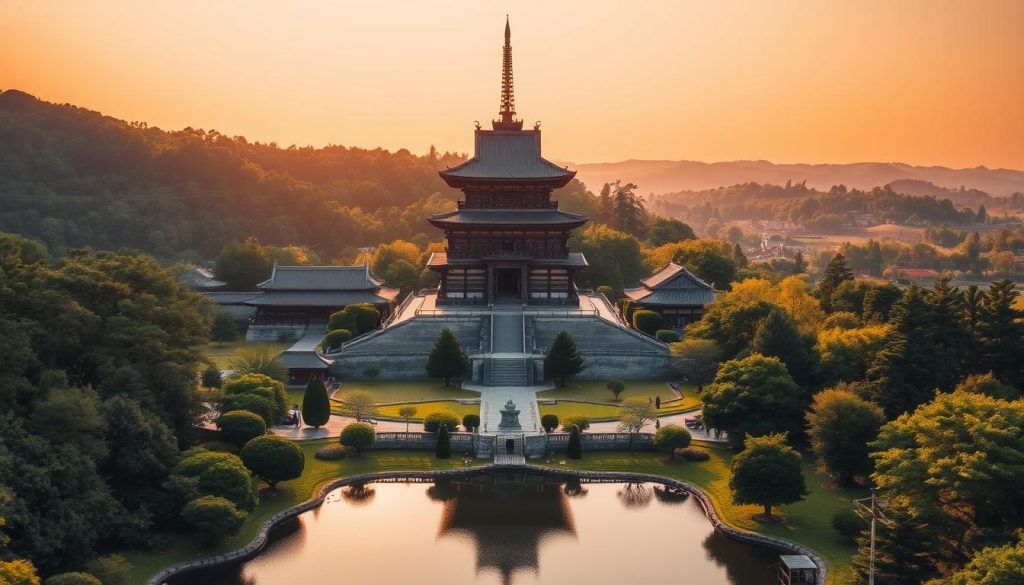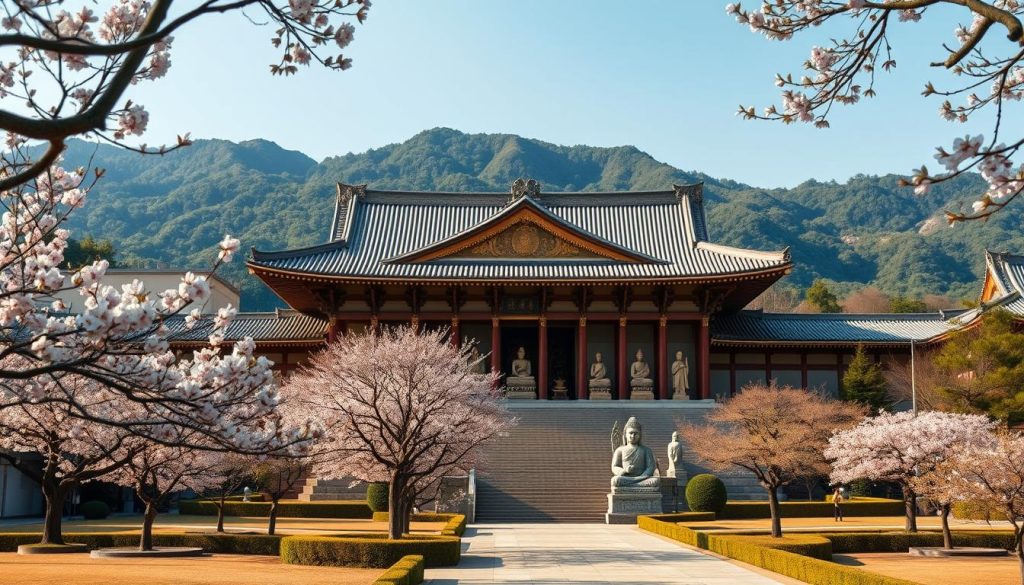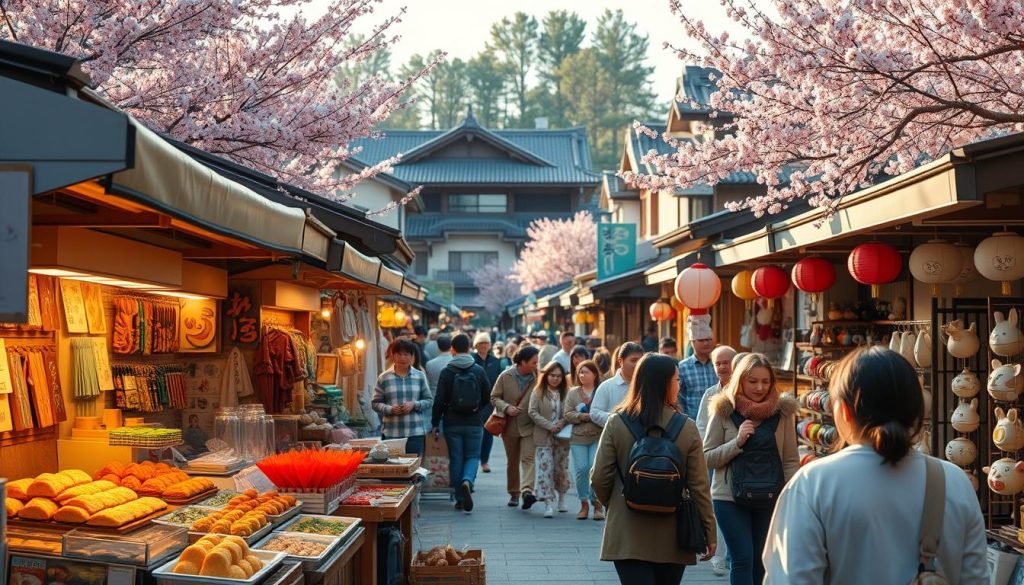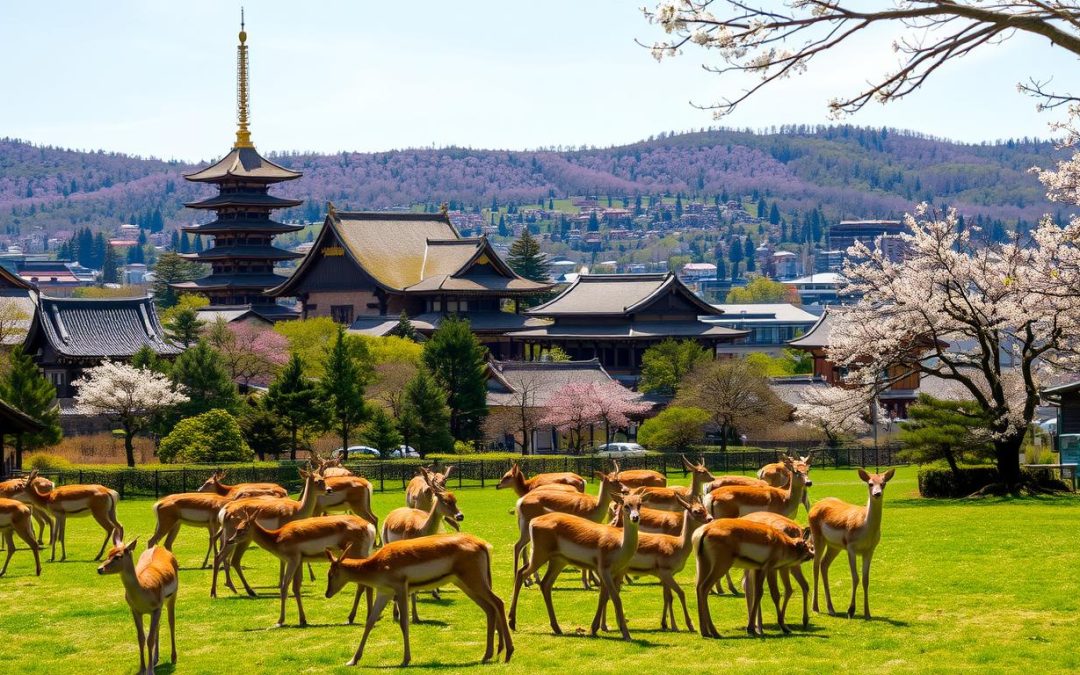Have you ever wondered what it’s like to step into a place where history, nature, and culture seamlessly blend? Just a short trip from Kyoto or Osaka, this destination offers a unique experience that’s hard to match. From ancient temples to serene parks, it’s a place where every corner tells a story.
This area is perfect for a day trip. You’ll find delicious snacks, roaming deer, and stunning landmarks. The compact sightseeing area makes it easy to explore on foot. Whether you’re visiting Tōdai-ji, home to the world’s largest wooden structure, or Kasuga Taisha with its iconic lanterns, there’s something for everyone.
Put on your walking shoes and get ready to discover a stress-free destination filled with rich cultural heritage. Let’s dive into the top picks that make this place truly special.
Key Takeaways
- Perfect day trip from Kyoto or Osaka.
- Blend of ancient temples and beautiful parks.
- Easy to explore on foot in a compact area.
- Famous attractions include Tōdai-ji and Kasuga Taisha.
- Home to friendly, roaming deer.
- Rich cultural heritage and stress-free exploration.
Top Attractions in Nara: Nara City, Japan: Best Things to Do – Top Picks
Step into a world where ancient traditions meet serene landscapes. This area is a treasure trove of history, culture, and natural beauty. Whether you’re a history buff or a nature lover, there’s something here for everyone.
Unmissable Landmarks
One of the most iconic sites is Tōdai-ji, home to the Great Buddha Hall. This massive wooden structure houses a 15-meter-tall bronze Buddha statue, a true marvel of craftsmanship. It’s a must-see for anyone visiting the area.
Another highlight is Kasuga Taisha, known for its lantern-lined pathways. This shrine has stood since the 8th century and offers a peaceful retreat. The stone and bronze lanterns add a magical touch, especially during festivals.
Don’t miss Nigatsu-dō, part of the Tōdai-ji complex. This hall offers stunning views of the surrounding park and is a perfect spot for reflection. Its design has evolved over centuries, showcasing the region’s rich architectural heritage.
Guide to the Must-See Sights
Exploring these landmarks is easy, thanks to the compact pedestrian-friendly area. You can walk from one site to another, soaking in the views along the way. The blend of modern conveniences and ancient sites makes it a stress-free experience.
- Tōdai-ji: Marvel at the Great Buddha and the world’s largest wooden building.
- Kasuga Taisha: Wander through lantern-lined paths and soak in the serene atmosphere.
- Nigatsu-dō: Enjoy panoramic views and a glimpse into centuries-old architecture.
Take your time to explore these landmarks. Each one offers a unique glimpse into the area’s rich history and culture. Whether you’re capturing photos or simply taking in the sights, it’s an experience you won’t forget.
Explore Iconic Temples and Shrines
Discover the heart of ancient traditions through its most iconic landmarks. These sites are not just architectural marvels but also windows into a rich spiritual and cultural heritage. From towering statues to serene pathways, each place tells a story that has stood the test of time.
Tōdai-ji Temple and the Great Buddha Hall
At the center of this area stands Tōdai-ji, a UNESCO World Heritage Site. Its Great Buddha Hall is the largest wooden structure in the world. Inside, you’ll find the Vairocana Buddha, a 15-meter-tall bronze statue that has amazed visitors for centuries.
This temple was built in the 8th century and served as the head temple of all provincial Buddhist temples. The craftsmanship and scale of the Great Buddha Hall are truly awe-inspiring. Don’t miss the Nandaimon Gate, the largest temple entrance gate in the area, guarded by towering statues.

Kasuga Taisha and Nigatsu-dō: Windows to History
Another must-visit is Kasuga Taisha, a shrine famous for its thousands of stone and bronze lanterns. Established in the 8th century, it’s a peaceful retreat with pathways lined with lanterns that light up during festivals. The shrine’s vibrant vermilion color stands out against the surrounding greenery.
Nearby, Nigatsu-dō offers stunning views of the area. Part of the Tōdai-ji complex, this hall hosts the annual Omizutori Festival, a tradition that dates back over 1,200 years. The festival’s rituals and ceremonies are a unique blend of history and spirituality.
Here are some tips for your visit:
- Wear comfortable shoes for walking between sites.
- Visit early in the day to avoid crowds.
- Take time to appreciate the intricate details of each structure.
These landmarks are more than just tourist attractions. They are a testament to the artistry, faith, and history that define this region. Whether you’re a history enthusiast or a spiritual seeker, these sites offer an unforgettable experience.
Experience Nature at Nara Park
Immerse yourself in a serene escape where nature and history intertwine effortlessly. This expansive green space is a haven for those seeking tranquility and a deeper connection to the environment. Whether you’re walking along shaded paths or enjoying panoramic views, the park offers a refreshing break from the hustle of urban life.
Stroll Among Friendly Deer
One of the most enchanting features of this area is its free-roaming deer. These gentle creatures are considered sacred and have become a symbol of the region. You can interact with them, feed them special crackers, and even capture memorable photos. The deer are accustomed to visitors, making the experience both safe and delightful.

Paths, Parks, and Panoramic Views
The park is designed for leisurely exploration. Its winding paths lead you through lush gardens, past historical landmarks, and to hidden spots perfect for relaxation. For the best views, head to elevated areas where you can see the entire landscape unfold before you. Don’t forget to bring your camera—every corner offers a picturesque moment.
“Walking through the park feels like stepping into a living painting, where nature and history coexist in perfect harmony.”
Here are some practical tips for your visit:
- Wear comfortable shoes for walking long distances.
- Visit early in the day to enjoy cooler temperatures and fewer crowds.
- Bring snacks and water, as the park is vast and you’ll want to take your time exploring.
| Activity | Details |
|---|---|
| Deer Feeding | Special crackers available for purchase. |
| Scenic Walks | Paths lead to temples, shrines, and viewpoints. |
| Photography | Plenty of spots for capturing nature and wildlife. |
This park is more than just a green space—it’s a place where you can truly unwind and connect with both nature and history. Whether you’re feeding the deer, walking the paths, or simply soaking in the views, it’s an experience that stays with you long after you leave.
Dive into Cultural Heritage and Museums
Uncover the layers of history and artistry that define this cultural haven. From ancient artifacts to sacred structures, this area offers a deep dive into centuries of tradition. Whether you’re an art enthusiast or a history buff, these sites provide a unique window into the past.
Nara National Museum Insights
The Nara National Museum is a treasure trove of Buddhist art and historical artifacts. Established in 1889, it houses one of the most extensive collections in the region. Here, you’ll find sculptures, paintings, and manuscripts that span over a thousand years.
One of the highlights is the Buddhist Art Gallery, which showcases intricate statues and relics. These pieces offer a glimpse into the spiritual and artistic practices of ancient times. The museum also hosts special exhibitions, making each visit a unique experience.

Admission is affordable, with tickets priced at around ¥700. Plan your visit during weekdays to avoid crowds and take your time exploring the exhibits. Combining a trip here with nearby temples makes for a full cultural day.
Kōfuku-ji Temple Complex Highlights
Another must-see is the Kōfuku-ji Temple, a historic complex that dates back to the 7th century. This site is known for its iconic five-story pagoda, which stands as a symbol of the area’s rich heritage. The temple has undergone several restorations, preserving its original beauty.
Within the complex, you’ll find the Eastern Golden Hall and the National Treasure Museum. These structures house important Buddhist statues and artifacts. The temple’s serene atmosphere makes it a perfect spot for reflection.
“Kōfuku-ji is not just a temple; it’s a living testament to the artistry and devotion of generations.”
Here are some tips for your visit:
- Wear comfortable shoes for walking around the expansive grounds.
- Visit early in the day to enjoy the peaceful ambiance.
- Combine your trip with a stop at the Nara National Museum for a complete cultural experience.
Together, the museum and temple offer a profound sense of heritage. They invite you to step back in time and appreciate the artistry and spirituality that shaped this region. Whether you’re exploring ancient relics or admiring architectural marvels, these sites leave a lasting impression.
Savor Local Flavors and Unique Souvenirs
Discover the flavors and crafts that bring this region’s culture to life. From savory street snacks to handcrafted treasures, every bite and item tells a story. Whether you’re exploring bustling markets or quaint stalls, you’ll find something to delight your senses.
Street Snacks and Traditional Treats
Start your culinary adventure with kakinoha-zushi, a local specialty made with vinegared rice and salted mackerel, wrapped in persimmon leaves. This dish is a must-try and reflects the area’s rich heritage. For something sweet, indulge in mochi, soft rice cakes often filled with red bean paste or matcha.

Don’t miss the chance to try narazuke, pickled vegetables with a unique flavor profile. These treats are often sold at food stalls near the Nandaimon Gate, a historic area perfect for a quick bite. Pair your snacks with a warm cup of tea for the full experience.
Shopping for Local Crafts
Take home a piece of this region’s charm with deer-themed souvenirs. These items, from keychains to pottery, celebrate the sacred deer that roam freely. You’ll also find traditional crafts like washi paper and hand-carved wooden items, each showcasing local artistry.
Visit the Nara Craft Center for a wide selection of handmade goods. Here, you can watch artisans at work and even try your hand at creating something unique. It’s a perfect way to connect with the area’s cultural heritage.
“Every bite and every craft tells a story, making your visit a journey through history and tradition.”
Here are some tips for your shopping and dining experience:
- Visit local markets early to avoid crowds and find the freshest items.
- Look for stalls near temples and parks for authentic snacks and crafts.
- Don’t hesitate to ask vendors about the history behind their products.
Whether you’re savoring street food or picking up a handmade souvenir, these experiences add depth to your visit. They offer a glimpse into the traditions and creativity that define this region.
Celebrate Nara’s Festivals and Seasonal Events
Experience the vibrant pulse of tradition and celebration in a place where festivals bring history to life. Throughout the year, this region comes alive with events that honor its rich heritage and spiritual roots. From ancient rituals to dramatic fire displays, there’s always something to captivate your senses.
Omizutori and Wakakusa Yamayaki
One of the most significant events is the Omizutori Festival, a purification ritual dating back over 1,200 years. Held at Nigatsu-dō, part of the Tōdai-ji complex, this festival features nightly torch-lit ceremonies that illuminate the temple grounds. It’s a mesmerizing experience that connects visitors to centuries of spiritual practice.
Another highlight is Wakakusa Yamayaki, where the grassy slopes of Mount Wakakusa are set ablaze in a dramatic spectacle. This event, held on the fourth Sunday of January, offers stunning views of the fire against the night sky. It’s a must-see for anyone visiting during winter.
Local Cultural Experiences Throughout the Year
Beyond these major events, the region hosts a variety of seasonal celebrations. In spring, the Kasuga Taisha Lantern Festival lights up the shrine’s pathways with thousands of lanterns. Autumn brings the Nara Tōkae Lantern Festival, where the park glows with thousands of lanterns, creating a magical atmosphere.
Here are some tips for enjoying these festivals:
- Plan your visit around major events like Omizutori and Wakakusa Yamayaki for a unique experience.
- Arrive early to secure a good spot, especially for fire-based events.
- Combine your festival visit with nearby attractions like the Nara National Museum for a full day of exploration.
“Festivals here are more than just events—they’re a living connection to centuries of tradition and spirituality.”
Whether you’re drawn to the spiritual depth of Omizutori or the fiery drama of Wakakusa Yamayaki, these festivals offer a glimpse into the heart of this region’s culture. Plan your trip around these events to make your visit truly unforgettable.
Getting Around Nara: Transportation and Connectivity
Exploring this area is a breeze, thanks to its well-connected transportation options. Whether you prefer walking, biking, or using public transit, getting around is simple and stress-free. The compact layout makes it easy to navigate, ensuring you spend more time enjoying the sights and less time figuring out directions.
Walking, Biking, and Public Transit Tips
One of the best ways to explore is on foot. The Kintetsu-Nara Station is just a short walk from Nara Park, making it a convenient starting point. The park’s central location means you can easily access nearby attractions like Tōdai-ji Temple and Kasuga Taisha Shrine without needing a vehicle.
For a quicker experience, consider renting a bike. Several rental shops are available near the station, offering affordable rates. Biking allows you to cover more ground while enjoying the scenic views. Just remember to follow local traffic rules and park your bike in designated areas.
Public transit is another excellent option. Local buses connect major attractions, and a day pass is a cost-effective way to hop on and off as you please. Buses are frequent, and routes are clearly marked, making it easy to plan your day. Here are some practical tips for getting around:
- Start your journey at Kintetsu-Nara Station for easy access to the park and nearby temples.
- Use local buses to move between attractions efficiently, especially if you’re short on time.
- Rent a bike for a faster and more flexible way to explore the area.
- Wear comfortable shoes if you plan to walk, as the terrain can be uneven in some areas.
With these options, you can maximize your sightseeing while enjoying the convenience of a well-connected city. Whether you’re strolling through the park or hopping on a bus, getting around is part of the adventure.
Insider Tips for a Perfect Day Trip
Planning a day trip to this historic area? Here’s how to make the most of your visit with insider tips and hidden gems. Whether you’re exploring ancient temples or strolling through serene parks, these practical suggestions will help you enjoy every moment.
Best Walking Routes and Hidden Gems
Start your journey at Kintetsu-Nara Station, a convenient spot close to Nara Park. From there, take a leisurely walk along Nobori-oji Street, where you’ll encounter friendly deer and scenic views. This route leads to Tōdai-ji Temple, home to the iconic Great Buddha Hall.
For a quieter experience, explore the Naramachi District, a historic area with traditional merchant houses. Here, you’ll find hidden shrines and charming cafes perfect for a break. Don’t miss Isui-en Garden, a peaceful spot often overlooked by tourists.
Advice on Timing and Must-Pack Essentials
To avoid crowds, visit major attractions like Kasuga Taisha early in the morning or late afternoon. This timing also offers the best lighting for photos. Plan to spend around 4-5 hours exploring, but take breaks to savor local snacks like kakinoha-zushi.
Pack comfortable shoes, a reusable water bottle, and a small backpack for essentials. A map or smartphone app can help you navigate easily. Here’s a quick checklist for your day trip:
| Item | Reason |
|---|---|
| Comfortable Shoes | Essential for walking long distances. |
| Water Bottle | Stay hydrated while exploring. |
| Snacks | Keep energy levels up during your visit. |
| Map or App | Navigate the area with ease. |
By following these tips, you’ll enjoy a seamless and memorable day trip. Take your time to soak in the history, culture, and natural beauty of this unique place.
Conclusion
From ancient temples to serene parks, this destination offers a unique blend of history and natural beauty. Its compact layout makes it easy to explore, whether you’re marveling at the Great Buddha or wandering through lantern-lined paths. The friendly deer add a touch of charm, making every visit memorable.
For a seamless experience, plan your trip around key attractions like the national museum and historic shrines. Early mornings or late afternoons are ideal for avoiding crowds. With convenient train connections to nearby areas like Kyoto, it’s a perfect day trip for history enthusiasts and nature lovers alike.
Take your time to soak in the views and embrace the rich heritage of this place. Whether you’re feeding the deer or exploring ancient sites, every moment here is a step into the past. Start planning your visit today and discover the magic waiting for you.
The above is subject to change.
Check back often to TRAVEL.COM for the latest travel tips and deals.
Here are some Tours & Sightseeing suggestions that might pique your interests!
